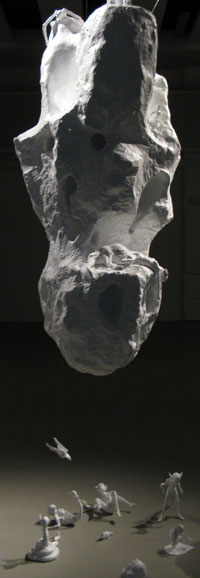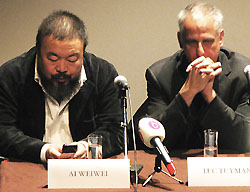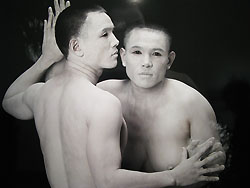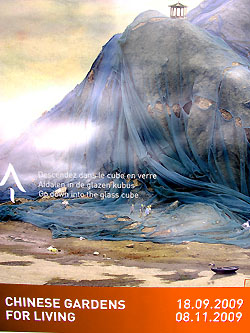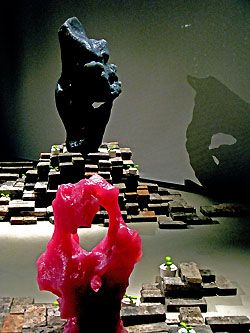|
|
| Europalia: Belgium Focuses on China
Celebrating its 40th anniversary, Europalia has embarked on a
gargantuan task: welcoming giant China to Lilliputian Belgium.
Beijing covers a geographic space that is roughly half the
size of Belgium, and its city limits encompass about 14 million
people. The entire population of Belgium is only 10 million.
The official line from Belgium at the opening ceremony on October
8, 2009, emphasized Europalia's benefit for Belgium's economy,interests,
and future. In contrast, Chinese vice-president, Xi Jinping,
focused on the cultural platform that Europalia is giving China
in Europe. 450 events, 50 exhibitions and 1,000 artists are
focusing on four themes: Perennial China, Contemporary China,
Colorful China, and China and the World. Visual arts, music,
theater, cinema, dance and literature will blanket all Belgium
until Chinese New Year's next February 14.
But, this
vast cultural extravaganza is not happening without criticism.
At the press conference for the opening of "The
State of Things," an exhibition on contemporary art
from both China and Belgium which is one of Europalia's first
events,
Belgium journalists questioned the inflated prices for contemporary
Chinese art, perceived Chinese imperialism, Tibet and human
rights. Interestingly enough, nobody mentioned the Uighurs.
A blog on
the website of the newspaper Le Soir displayed a succession
of comments ranging from the inflammatory to the nuanced.
Some readers
expressed shock at inviting China because of its history
of human rights violations. There is a tendency by the broad
public in
the West to focus on classical China while failing to appreciate
what is happening in contemporary China. One of Le Soir's
bloggers asked why photos were included showing Mongols,
the blogger obviously
was not aware that Inner Mongolia is part of China.
Both Ai Weiwei
and Luc Tuymans insist that the exhibition is a "momentum" that does not necessarily include the "stars" of
the art world. The curators do not provide any guidelines. "We
want the public to make the judgment," says Ai Weiwei. And
Luc Tuymans adds: " It is a show about art and artists in
order to bring us further away." Once the selection
was made on each side, both curators tried to juxtapose
their selections.
The Palais des Beaux-Arts may not have been the right place.
An old structure, it is composed of a series of small rooms
with limited space to stand back and absorb the juxtaposition.
Many
people found
Though juxtaposition of artwork is one of the objectives of this exhibition, Chi Peng's work stands by itself in a room. For me, it is the most powerful and meaningful work in this exhibition. "Sprinting Forward-2" is reproduced everywhere as the flagship of the exhibition. For this artist, who is only 28 years old, sprinting forward is the epitome of young Chinese urbanites looking for independence, freedom, and a sense of themselves, which results from the one-child policy much as people once sought the American Dream. The perfect, youthful body of this young man, the artist himself, is a symbol of the freshness of a society trying to rebuild its principles. In this image as in much of his work, elements of technology are in motion that is in parallel to the contemporary world of knowledge, hopes and frustrations that continue to suffocate our destiny. But as a young artist, Chi Peng offers us his determination to escape into the future by using his naked body without any restraint. Some critics explain that the planes represent a sort of surveillance above a vulnerable youth.
The beautiful
photo entitled "Consubstantiality1," suggests
a connection between the artist and homosexuality.
The artist inhabits the tension of the photographic space by
playing with
a sexless figure. As Feng Boyi, a curator and commentator
of Chi Peng, explains, "He (Chi Peng) begins his
works with ego-cognition, from egovirtualization to
ego-identity."
The title
of Boris Vian's book, "J'irai cracher sur vos
tombes," is the inspiration for the Belgian artist Jan Fabre's
work, "I spit on my own Tomb," an installation done
in 2007. It gruesomely welcomes the visitor with a life-size
representation of a man standing in the middle of an accumulation
of 250 gravestones. The man elegantly
wears a white costume,
and from time to time actually spits on the pile of dark granite
stones. The inscriptions on the stones list names of living and
extinct insects with dates of birth or birth and death of artists,
philosophers, scientists...whose names are not inscribed on the
stones. The references are given on a list that the visitor can
consult. The search for the relationship between dates and names
is irrelevant, even absurd, because it is the perpetual process
of creative thinking that has to nourish us. Spitting on life
and on death is a provocative act per se, but saliva is a body
fluid like blood, sweat, sperm, and tears. A new life may emerge
as the link between mind and body. Jan Fabre, who was born in
Antwerp in 1958, is a multidisciplinary artist. His installation "From
Feet to Brain" was exhibited at the 2009 Biennale
of Venice.
A two-minute walk from BOZAR, at the former Palais des Congrès, in a new space called "Square," an exhibit, "Chinese Gardens for Living," brings us into the metaphorical world of contemplation by exploring the traditional components and philosophy behind the Chinese garden. The architectural display of the exhibition is composed of successive rows of semi-translucent curtains that form walls, which we have to pass through one after the other. The general ambience here is not the green of a garden, but off-white, subdued in a semi-obscurity, to facilitate our travel through our own subconscious. The exhibition includes photographs, sculptures, paintings and architectural projects. The curator, Tang Keyang, surprises the visitor. Instead of real grass, flowers, rocks, water, bricks, we have paper, canvas, iron, clay, plaster, silicone... Tang Keyang invites us to envision a garden as "a system which is still under development." Extracting the concept of the Chinese Garden, contemporary artists play with materials that do not belong to the physical garden. Traditionally, the components enter into a mutual dialogue based on the principle of Yin and Yang, complementary forces generated by the cosmic Dao. Four themes or dialogues are established by the curator: Illusions, Adored Objects, Drama, and Reality. Photographs and paintings belong to the world of illusion because reality is transferred to paper or canvas. Adored Objects reflects on tangible objects that can be transmuted in the sphere of a universal garden. Drama gives an opportunity for the artist to communicate with the world through the concept of garden and Reality focuses on architectural projects.
Moving through the rows of translucent fabrics and semi-obscurity
dedramatize the garden as a unique force. We are encouraged to
reevaluate the energetic forces of the different elements of
the garden and to reverse the process: going from detachment
towards a density that we have to re-invent. It is thus a process
from simplicity towards the global to which the artists invite
us and leave us the choice of discovery or reinvention.
This
article was first published in the internet magazine The
Essential Edge. Michèle
Vicat is one of the arts editors for The Essential Edge. |
All material copyright 2010 by 3 dots water


